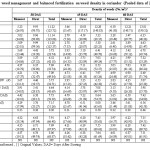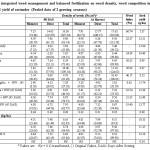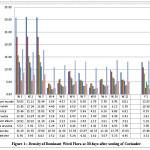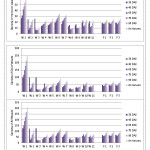Introduction
Coriander (Coriandrum satvium L.), an annual herbaceous plant of Apiaceae family, is one of the important seed spices occupying a prime position throughout the world to add taste, flavor and pungency in various food items. Moreover, it is a frequent ingredient in the preparation of Ayurvedic medicines and is a traditional home therapy for different ailments viz. rheumatism, joint pain, gastrointestinal complaints, flatulence, indigestion, insomnia, convulsion, anxiety, loss of appetite etc. India is the largest producer of coriander with a production of almost 90 per cent of the total world’s supply.4 It is consumed in large quantities and earns 2920 million Rupees. a large sum of foreign exchange through export of 30.30 thousand tonnes every year.9 Coriander is remunerative and short duration crop cultivated in rabi season under irrigated conditions.
Weed management and balanced fertilization is crucial for crop for its growth and ultimate expression of yield. Weeds compete with crop plants for water, nutrients, space and solar radiations resulting in reduction of yield by 20 to 50 %.1 To bridge the gap between actual and potential levels of production, an effective weed management practice has to be worked out. Evaluation of efficient herbicides suited to a particular climatic situation for a targeted group of plants needs immediate attention. To have higher productivity levels, nutrient management strategies are also equally important. In intensive agriculture, adoption of exhaustive high yielding varieties has led to heavy withdrawal of nutrients from the soil and this has created nutrient imbalance. Balanced fertilization involving application of N, P, K and S in optimum quantity and right proportion suited for specific crop climate situation is of prime importance to enhance the productivity of coriander and sustain the soil health. Therefore, the present investigation was planned to assess the effect of selected herbicides with or without hand weeding and balanced fertilization on weed dynamics and yield of coriander and to find out the interaction effect on yields.
Methodology
The field experiment was conducted during winter seasons at Instructional Farm, Rajasthan College of Agriculture, Udaipur, India. The soil is clay loam having medium available N (276.83 kg/ha) & available P (18.99 kg/ha), high K (365.54 kg/ha) and S (10.02 ppm) pH 8. Thirty-three treatment combinations, comprising 11 weed management practices in main plots [W1=weedy check, W2=one hand weeding (HW) at 30 days after sowing (DAS), W3=two HW at 30 and 45 DAS, W4=pendimethalin 1.0 kg/ha, W5=oxyfluorfen 0.25 kg/ha, W6=metribuzin 0.30 kg/ha, W7=oxadiargyl 75 g/ha, W8=pendimethalin 1.0 kg/ha + HW at 45 DAS, W9=oxyfluorfen 0.25 kg/ha + HW at 45 DAS, W10=metribuzin 0.30 kg/ha + HW at 45 and W11=oxadiargyl 75 g/ha + HW at 45 DAS] and 3 balanced fertilization treatments in sub plots (F1=N60 + P30, F2=N60 + P30 + K30 and F3=N60 + P30 + K30 + S30 kg/ha) were laid out in a split plot design with 3 replications. Coriander variety ‘CS-6’ was used for sowing. The seeds were sown in furrows spaced 30 cm apart keeping a seed rate of 15 kg/ha. All herbicides were applied as per emergence at 2 DAS, while hand weeding was done at 30 and 45 DAS as per treatments. Half dose of N and full dose of P, K and S was applied basal through urea, DAP, MOP and gypsum and remaining half dose of N was top dressed at 30 DAS. Each experimental plot was surveyed using 0.25 m2 quadrate for studying weed composition in the experiment and then converted into number of weeds/m2 at 30 DAS. Further, all weeds were counted category wise (monocot and dicot) at 30, 45, 60, 75, 90 DAS and harvest of crop. Two representative spot were selected randomly for this purpose in each plot. Mean of these two spot were selected for calculation. The mean data were expressed as number/m2. The data on weed density were subjected to square root transformation √x+0.5 to normalize their distribution.6 For calculation of seed yield of coriander, the produce from net plot was harvested, tagged, dried under shade for 15-20 days, threshed and winnowed. Well cleaned seed material was weight and recorded as kg/plot and finally converted to q/ha. The seed yield of respective plots was added to straw yield to record biological yield/plot and finally presented as q/ha.
Statistical Analysis
In order to test the significance of data recorded, they were subjected to statistical analysis through standard procedure as suggested by author6 using technique of analysis of variance (ANOVA) for split plot design. The significance in treatment effects was adjudged by calculating critical difference (CD) at 5 per cent level of significance wherever, the results were found significant by ‘F’ test. MSTAT software of Michigan State University, USA was used for calculation of ANOVA and CD.
Weed competition index (%) at harvest was worked by the following formula.11

Results and Discussion
Weed Cover and Diversity
The major weed flora reported in the experimental site was Goose foot (Chenopodium murale L.), Corn spurry (Spergula arvensis L.), Indian sweet clover (Melilotus indica L.), Scarlet pimpernel (Anagallis arvensis L.), Common lambsquarters (Chenopodium album L.), Field bindwind (Convolvulus arvensis L.), Purple nutsedge (Cyperus rotundus L.) and Bermudagrass (Cynodon dactylon L.). From these weeds, Goose foot (Chenopodium murale L.) and Corn spurry (Spergula arvensis L.) among dicots and Purple nutsedge (Cyperus rotundus L.) among monocots were found most prominent weeds at all stages of crop growth. The proportion of these weed species at 30 DAS were 24.50, 18.33 and 14.48 per cent, respectively of the total weed flora in the control plot (Figure 1). These three species together comprised of 57.31 per cent of the total weed density at the experimental site. Greater density of Chenopodium murale, Spergula arvensis and Cyperus rotundus may be due to the fact that these weeds have quick germination and survival capacity as well as greater competitive ability than other weeds.7 Comparatively lower weed density of all weed species was observed under two HW at 30 and 45 DAS and pendimethalin 1.0 kg/ha + one HW at 45 DAS treatments. Moreover, of the total eight weed species reported, the six falls under the category of dicot weeds.
Effect of Weed Management on Weed Density
The category wise density of weed flora reported at 30, 45, 60, 75, 90 DAS and harvest of crop under weed management practices is depicted in Figure 2 and presented in Table 1 and 2. An examination of data on weed density indicates that density of all weeds fluctuated to a great extent due to different weed management practices at crop growth stages. Weedy check plot was noted to be the most severely infested by weeds during both the years. The total weed population of 125.72/m2 recorded in weedy check plot at 30 DAS attaining its maximum value of 310.08/m2 at harvest.
All weed management practices affects monocot and dicot weed flora population as compared to weedy check and lowest population was reported by two HW at 30 and 45 DAS followed by pendimethalin 1.0 kg/ha + one HW at 45 DAS treatments. The treatment of two HW at 30 and 45 DAS found to be most effective measure and represented the significantly lowest total weed population over pendimethalin 1.0 kg/ha + one HW at 45 DAS and rest of treatments at 45, 60, 90 and at harvest of crop. This might be due to the fact that one HW at 30 DAS could retain weed free environment up to 45-50 days only.10 Thereafter, the population of weeds increased progressively with the advancement of crop growth due to late flushes of weeds and considerably higher density of weeds was recorded at subsequent stages. On the contrary, another HW at 45 DAS done under two HW treatments removed second flush of weeds provided weed free environment to crop throughout the growing season.8
Among all the herbicidal Treatments metribuzin resulted in poorest weed control over weedy check especially at later stages which might be due to its high water solubility and less persistence in soil system.13 On the other hand, oxyfluorfen and oxadiargyl were found inferior to pendimethalin but significantly superior over weedy check. Oxyflurofen and oxadiargyl exert their phototoxic effect through contact action on germinating weeds. Pendimethalin being dinitroaniline, is known to be absorbed by germinating weeds and inhibits cell division in meristematic tissue so that most of weeds die within few days of their emergence.5 Application of pendimethalin followed by One HW at 45 DAS performed very well in controlling weeds because of the fact that emergence and early growth of weeds was inhibited by pendimethalin alone whereas later emerging weeds were effectively controlled by implication of HW at 45 DAS.3
Weed Competition Index and Coriander Yield
The lowest weed competition index was recorded in pendimethalin 1.0 kg/ha + one HW at 45 DAS (Table 2). The herbicides and their integration with hand weeding lowered weed competition index as compared to control. These treatments resulted in effective and timely control of weeds and did not allow weeds to regenerate and therefore lower weed competition index was recorded. Similar trend of results has also been obtained by researchers14 for weed competition index.
The highest seed yield (15.84 q/ha) and biological yield (41.11 q/ha) of coriander was obtained under two HW treatment, followed by pre emergence application of pendimethalin 1.0 kg/ha + HW at 45 DAS (15.74 and 39.62 q/ha, respectively) and both treatments remained at par to each other, but proved superior over rest of practices. The increase in seed and biological yield with weed management measures is believed to be an indirect expression of reduction in weed crop competition which significantly helped in increasing yields.2 Any of the weed management practices failed to produce significant effect on harvest index (%) of crop, however maximum harvest index of 39.77 % was obtained with pendimethalin 1.0 kg/ha + HW at 45 DAS. This might be due to the fact that harvest index, being an indicator of assimilate partitioning efficiency of plant measured by dividing seed yield from biological yield and expressed as percentage. The all weed management practices although reduce weed crop competition which later reflected in increasing seed and biological yields but fails to affect assimilate partitioning efficiency of plant due to more stable genetic characteristics.12 The weed management practices increased seed and biological yields in the same proportion therefore the effect on harvest index was not lasting and remained non significant.
 |
Table 1: Effect of integrated weed management and balanced fertilization on weed density in coriander (Pooled data of 2 growing seasons) Click here to View table |
 |
Table 2: Effect of integrated weed management and balanced fertilization on weed density, weed competition index, seed and biological yield of coriander (Pooled data of 2 growing seasons) Click here to View table |
Table 3: Interaction effect of integrated weed management and balanced fertilization on seed and biological yield of coriander (pooled data of 2 growing seasons)
| Weed management |
Seed Yield ( q/ha) |
Biological Yield ( q/ha) |
||||
|
N+P |
N+P+K |
N+P+K+S |
N+P |
N+P+K |
N+P+K+S |
|
| Weedy check |
5.24 |
5.26 |
5.31 |
13.98 |
14.10 |
14.30 |
| One HW (30 DAS) |
12.21 |
12.27 |
12.46 |
32.20 |
32.48 |
33.00 |
| Two HW (30 and 45 DAS) |
14.07 |
15.71 |
17.75 |
36.67 |
39.90 |
46.76 |
| Pendimethalin 1.0 kg/ha |
9.77 |
10.65 |
10.77 |
25.56 |
27.74 |
27.71 |
| Oxyfluorfen 0.25 kg/ha |
8.42 |
9.24 |
9.32 |
22.75 |
24.82 |
24.69 |
| Metribuzin 0.30 kg/ha |
7.84 |
8.59 |
8.37 |
20.61 |
22.31 |
21.73 |
| Oxadiargyl 75 g/ha |
8.04 |
8.78 |
8.77 |
21.19 |
22.99 |
22.68 |
| Pendimethalin 1.0 kg/ha + HW (45 DAS) |
14.00 |
15.51 |
17.72 |
35.16 |
38.10 |
45.61 |
| Oxyfluorfen 0.25 kg/ha + HW (45 DAS) |
11.74 |
13.05 |
14.98 |
32.89 |
35.42 |
39.47 |
| Metribuzin 0.30 kg/ha + HW (45 DAS) |
11.04 |
12.15 |
14.24 |
29.62 |
33.56 |
36.68 |
| Oxadiargyl 75 g/ha + HW (45 DAS) |
11.30 |
12.56 |
14.26 |
30.87 |
33.82 |
36.81 |
| CD (P=0.05) for balanced fertilization at same weed management practice |
1.14 |
2.94 |
||||
| CD (P=0.05) for weed management at same level of balanced fertilization |
1.22 |
3.13 |
||||
Effect of Balanced Fertilization on Weed Density and Coriander Yields
Balanced fertilization practices did not influence the weed density, significantly (Table 1 and 2). On the other hand, balanced fertilization with N+P+K+S significantly enhanced crop seed yield by 9.26 per cent over N+P fertilization and 8.36 per cent over N+P+K fertilization. Biological yield of coriander also significantly enhanced by N+P+K+S fertilization as compared to N+P and N+P+K fertilization. The significantly higher values of these parameters with N+P+K+S balanced nutrition could be ascribed to be due to the fact that balanced fertilization play an important role in growth and development of plant and exploitation of crop genetic potential up to greatest extent. The results corroborate with the findings of.15
Interaction Effect of Weed Management and Balanced Fertlization
Interactive effect of weed management and balanced fertilization was also found significant in respect of seed yield and biological yield of coriander (Table 3). On pooled basis, two hand weeded plots fertilized with N+P+K+S recorded significantly higher seed yield (17.75 q/ha) of coriander as compared to two HW with N+P (14.07 q/ha) or N+P+K (15.71 q/ha) fertilization alone. Among herbicidal integrations, maximum seed yield (17.72 kg/ha) was obtained with pendimethalin+HW along with N+P+K+S fertilization, and this combination remained at par with two HW combined with N+P+K+S fertilization. Similarly, maximum biological yield was reported under two HW with N+P+K+S fertilization (46.76 q/ha) and remained at par with pendimethalin+HW along with N+P+K+S fertilization (45.61 q/ha). Thus it could be concluded that weeds in coriander should be controlled by pre-emergence application pendimethalin 1.0 kg/ha followed by one HW at 45 DAS and crop should be fertilized with 60 kg N + 30 kg P2O5 + 30 kg K2O + 30 kg S/ha-1 to get higher seed yield.
 |
Figure 1: Density of Dominant Weed Flora at 30 days after sowing of Coriander. Click here to View figure |
 |
Figure 2: Density of Weeds at coriander growth stages. Click here to View figure |
Conclusion
Among all weed species reported, dicot weeds were found most prominent weeds in their infestation throughout the crop season. The pendimethalin + HW combined with N+P+K+S fertilization was found superior treatment combination for obtaining higher yields in coriander, whereas two HW at 30 and 45 DAS together with N+P+K+S fertilizations was appeared to be next best treatment combination.
Acknowledgements
The authors were gratefully acknowledged coordinal thanks to the Professor and Head, Department of Agronomy, Rajasthan College of Agriculture, Maharana Pratap University of Agriculture and Technology, Udaipur (Rajasthan) for providing all necessary facilities to carry out this study.
References
- Bhan, V.M. Status of research on weed science and its impact. Presented at the Sevennteenth Meeting of the Governing Body of the ICAR, New Delhi. 1998.
- Choudhary G R and Gupta O P. Response of cumin (Cuminum cyminum) to nitrogen application, weed control and sowing methods. Indian Journal of Agronomy. 1991;36:212-216.
- Choudhary, G R. Weed population dynamics and fennel (Foeniculum vulgare) growth as influenced by integrated weed management. Indian Journal of Agronomy. 2000;45:421-428.
- D.M. Panara , R.K. Mathukia and B.K. Sagarka. Efficient Weed Management in Coriander (Coriandrum sativum L.). Agriculture: Towards a New Paradigm of Sustainability 2015:48-51.
- Eshel, Y., Oheli, Y., Garjig, G., Yager, D. and Azad, I. Pendimethalin a new selective herbicide for cotton and other crops. Phytoparasitica 1979;7:143.
- Gomez, K. A. and Gomez, A. A. Statistical procedure for agricultural research. 2nd Ed. John Willy & Sons Inc. New York, USA . 1984;316-355.
- Gupta, O. P. Scientific weed management in the tropics and subtropics. Today and tomorrow’s printers and publishing, New Delhi, India. 1984
- Gora D. R., Meena N. L. and Shivran P. L. Effect of weed control and time of nitrogen application in cumin (Cuminum cyminum). Indian Journal of Agronomy. 1996;41:500-501.
- Item wise export of spices from India. Spices Board of India, Ministry of Commerce and Industry, Govt. of India : URL- http://www.indianspices.com/sites/default/files/Major Item wise Export 2016-17.pdf . 2016-17
- Jat, R. C. Studies on weed control on cumin (Cuminum cyminum L.) M.Sc (Ag) Thesis, Sukhadia University, Udaipur (India).1987.
- Kushwaha, H. S., Tripathi, M. L. and Singh, V. B. Weed management in coriander (Coriandrum sativum). Presented at second International Agronomy Congress at New Delhi, India. 2002;26-30
- Mehta, J.P. weed management and nitrogen application in fennel (Foeniculum vulgare Mill). M.Sc. Thesis, RAU, Bikaner (Rajasthan) India. 2000
- Rao, V.S. Principles of weed science. Oxford and IBH Publishing Co. Pvt. Ltd., New Delhi, India. 2000.
- Sethivel T. Chemical weed control in rainfed coriander. Indian Journal of Agronomy. 2001;88:532-533.
- Tripathi A K, Pandya R K and Tripathi M L. Effect of nitrogen, phosphorus and potassium on stem gall disease and yield of coriander. Annals of Plant Protection Sciences. 2001;9:337-339.

